Experimental Investigations on the Performances of Composite Building Materials Based on Industrial Crops and Volcanic Rocks
Abstract
1. Introduction
2. Materials and Methods
2.1. Raw Materials
2.1.1. Hemp Shiv
2.1.2. Volcanic Rocks
2.1.3. Binders
2.2. Preparation of New Composite Materials
2.3. Visual Analysis
2.4. Chemical Characterization
2.5. Morphological Analysis
2.6. Thermogravimetry Analysis
2.7. Bending Core Cohesion
2.8. Mechanical Properties
2.9. Thermal Properties
2.10. Acoustic Properties
3. Results and Discussions
3.1. Chemical Characterization
3.2. Petrographic Features
3.3. Thermal Analysis
3.4. Bending Core Cohesion
3.5. Mechanical Properties
3.6. Thermal Properties
3.7. Acoustic Properties
4. Conclusions
- The X-ray diffraction helped interpret the hydration process of the cement related to the raw materials;
- The SEM images showed new crystalline bonds that formed in the composition of the new hemp based materials;
- The thermal analysis revealed that, by adding vermiculite to the composition, the degradation of the composites at higher temperature will be slowed down;
- For the fire behavior, the presence of perlite and vermiculite increased the fire resistance of the organic material;
- The mechanical characteristics of the materials are especially defined by the ratio of the binder with water and binder with raw materials. The best performing composite for flexural and compressive strength is the one based on perlite and vermiculite;
- The thermal conductivity is related to the bulk density of the composite. Increasing the pore structure of a material will contribute to a lower density, which will lead to a decreased value of the thermal conductivity. By using perlite in the composites the value of the thermal conductivity will decrease;
- In terms of sound absorption coefficient, the presence of vermiculite in the mixtures increases the acoustic performance of the new composite materials.
Author Contributions
Funding
Conflicts of Interest
References
- Tuladhar, R.; Yin, S. Sustainability of Using Recycled Plastic Fiber in Concrete; Elsevier Ltd.: Amsterdam, The Netherlands, 2019. [Google Scholar]
- Maria, C.; Andreş, D.; Manea, D.L. Using Wheat Straw in Construction. Available online: https://www.google.com.hk/url?sa=t&rct=j&q=&esrc=s&source=web&cd=1&ved=2ahUKEwiu9fT668XnAhXFdd4KHSR_CwQQFjAAegQIAhAB&url=http%3A%2F%2Fjournals.usamvcluj.ro%2Findex.php%2Fpromediu%2Farticle%2Fdownload%2F11216%2F9198&usg=AOvVaw0myBXdWhQ_o3NqZBIMrblK (accessed on 10 February 2020).
- Jami, T.; Karade, S.R.; Singh, L.P. A review of the properties of hemp concrete for green building applications. J. Clean. Prod. 2019, 239, 117852. [Google Scholar] [CrossRef]
- Tamas-Gavrea, D.-R.; Istoan, R.; Tiuc, A.E. Multilayered Composite Panel and the Method Used for Obtaining it. Patent Application No. A00288, 24 April 2018. [Google Scholar]
- Hamard, E.; Cazacliu, B.; Razakamanantsoa, A.; Morel, J. Cob, a vernacular earth construction process in the context of modern sustainable building. Build. Environ. 2016, 106, 103–119. [Google Scholar] [CrossRef]
- Dénes, O.; Florea, I.; Manea, D.L.; Afonso, P. Utilization of sheep wool as a building material. Procedia Manuf. 2019, 32, 236–241. [Google Scholar] [CrossRef]
- Petrounias, P.; Giannakopoulou, P.P.; Rogkala, A.; Lampropoulou, P.; Tsikouras, B.; Rigopoulos, I. Petrographic and Mechanical Characteristics of Concrete Produced by Different Type of Recycled Materials. Geosciences 2019, 9, 264. [Google Scholar] [CrossRef]
- Abdallah, S.; Fan, M. Characteristics of concrete with waste glass as fine aggregate replacement. Int. J. Eng. Technol. Res. 2014, 2, 6. [Google Scholar]
- Tiuc, A.B.; Rusu, T.; Vasile, O. Investigation Composite Materials for its Sound Absorption Properties. Available online: https://www.researchgate.net/publication/258212172_Investigation_composite_materials_for_its_sound_absorption_properties (accessed on 10 February 2020).
- Bedlivá, H.; Isaacs, N. Hempcrete—An environmentally friendly material ? Adv. Mater. Res. 2014, 1041, 83–86. [Google Scholar] [CrossRef]
- Hamzaoui, R.; Guessasma, S.; Abahri, K. Mechanical Performance of Mortars Modified with Hemp Fibres, Shives and Milled Fly Ashes. Available online: https://www.researchgate.net/publication/319879827_Mechanical_performance_of_mortars_modified_with_hemp_fibres_shives_and_milled_fly_ashes (accessed on 10 February 2020).
- Hirst, E.A.J. Characterisation of Hemp-Lime As a Composite Building Material. Available online: https://researchportal.bath.ac.uk/en/publications/characterisation-of-low-density-hemp-lime-composite-building-mate (accessed on 10 February 2020).
- Mazhoud, B.; Collet, F.; Pretot, S.; Chamoin, J. Hygric and thermal properties of hemp-lime plasters. Build. Environ. 2016, 96, 206–216. [Google Scholar] [CrossRef]
- Kinnane, O.; Reilly, A.; Grimes, J.; Pavia, S.; Walker, R. Acoustic absorption of hemp-lime construction. Constr. Build. Mater. 2016, 122, 674–682. [Google Scholar] [CrossRef]
- Diquélou, Y.; Gourlay, E.; Arnaud, L.; Kurek, B. Impact of hemp shiv on cement setting and hardening: Influence of the extracted components from the aggregates and study of the interfaces with the inorganic matrix. Cem. Concr. Compos. 2015, 55, 112–121. [Google Scholar] [CrossRef]
- Diquélou, Y.; Gourlay, E.; Arnaud, L.; Kurek, B. Influence of binder characteristics on the setting and hardening of hemp lightweight concrete. Constr. Build. Mater. 2016, 112, 506–517. [Google Scholar] [CrossRef]
- Balčiūnas, G.; Pundienė, I.; Boris, R.; Kairytė, A.; Žvironaitė, J.; Gargasas, J. Long-term curing impact on properties, mineral composition and microstructure of hemp shive-cement composite. Constr. Build. Mater. 2018, 188, 326–336. [Google Scholar] [CrossRef]
- Fernea, R.; Tǎmaş-Gavrea, D.R.; Manea, D.L.; Roşca, I.C.; Aciu, C.; Munteanu, C. Multicriterial Analysis of Several Acoustic Absorption Building Materials Based on Hemp. Procedia Eng. 2017, 181, 1005–1012. [Google Scholar] [CrossRef]
- Fernea, R.; Florea, I.; Manea, D.L.; Pǎşcuţǎ, P.; Tǎmaş-Gavrea, D.R. X-ray diffraction study on new organic- natural building materials. Procedia Manuf. 2018, 22, 372–379. [Google Scholar] [CrossRef]
- Koksal, F.; Gencel, O.; Kaya, M. Combined effect of silica fume and expanded vermiculite on properties of lightweight mortars at ambient and elevated temperatures. Constr. Build. Mater. 2015, 88, 175–187. [Google Scholar] [CrossRef]
- Silva, L.M.; Ribeiro, R.A.; Labrincha, J.A.; Ferreira, V.M. Cement & Concrete Composites Role of lightweight fillers on the properties of a mixed-binder mortar. Cem. Concr. Compos. 2010, 32, 19–24. [Google Scholar]
- Garcı, P.A.; Lanzo, M. Lightweight cement mortars: Advantages and inconveniences of expanded perlite and its influence on fresh and hardened state and durability. Constr. Build. Mater. 2008, 22, 1798–1806. [Google Scholar]
- Dunn, V. Collapse of Burning Buildings, 2nd ed.; PennWell: Tulsa, OK, USA, 2010. [Google Scholar]
- Hussain, A.; Calabria-holley, J.; Lawrence, M.; Ansell, M.P.; Jiang, Y.; Schorr, D.; Blanchet, P. Development of novel building composites based on hemp and multi- functional silica matrix. Compos. Part B 2019, 156, 266–273. [Google Scholar] [CrossRef]
- Pantawee, S.; Sinsiri, T.; Jaturapitakkul, C.; Chindaprasirt, P. Utilization of hemp concrete using hemp shiv as coarse aggregate with aluminium sulfate [Al2(SO4)3] and hydrated lime [Ca(OH)2] treatment. Constr. Build. Mater. 2017, 156, 435–442. [Google Scholar] [CrossRef]
- Jia, X.; Ansell, M.P.; Hussain, A.; Lawrence, M.; Jiang, Y. Physical Characterisation of Hemp Shiv: Cell Wall Structure and Porosity. In Proceedings of the 2nd International Conference on Bio-Based Building Materials & 1st Conference on ECOlogical valorisation of GRAnular and FIbrous Materials, Clermont-Ferrand, France, 21–23 June 2017. [Google Scholar]
- Abraham, R.E.; Wong, C.S.; Puri, M. Enrichment of cellulosic waste hemp (Cannabis sativa) hurd into non-toxic microfibres. Materials 2016, 9, 562. [Google Scholar] [CrossRef]
- Terpáková, E.; Kidalová, L.; Eštoková, A.; Čigášová, J.; Števulová, N. Chemical modification of hemp shives and their characterization. Procedia Eng. 2012, 42, 931–941. [Google Scholar] [CrossRef]
- Stevulova, N.; Cigasova, J.; Estokova, A.; Terpakova, E.; Geffert, A.; Kacik, F.; Singovszka, E.; Holub, M. Properties characterization of chemically modified hemp hurds. Materials 2014, 7, 8131. [Google Scholar] [CrossRef] [PubMed]
- Chabannes, M.; Garcia-Diaz, E.; Clerc, L.; Bénézet, J.C. Effect of curing conditions and Ca(OH)2-treated aggregates on mechanical properties of rice husk and hemp concretes using a lime-based binder. Constr. Build. Mater. 2016, 102, 821–833. [Google Scholar] [CrossRef]
- Delannoy, G.; Marceau, S.; Glé, P.; Gourlay, E.; Guéguen-Minerbe, M.; Diafi, D.; Nour, I.; Amziane, S.; Farcas, F. Influence of binder on the multiscale properties of hemp concretes. Eur. J. Environ. Civ. Eng. 2019, 23, 609–625. [Google Scholar] [CrossRef]
- Brzyski, P.; Barnat-Hunek, D.; Suchorab, Z.; Lagód, G. Composite materials based on hemp and flax for low-energy buildings. Materials 2017, 10, 510. [Google Scholar] [CrossRef]
- Stevulova, N.; Estokova, A.; Cigasova, J.; Schwarzova, I.; Kacik, F.; Geffert, A. Thermal degradation of natural and treated hemp hurds under air and nitrogen atmosphere. J. Therm. Anal. Calorim. 2017, 128, 1649–1660. [Google Scholar] [CrossRef]
- De Oliveira, A.G.; Jandorno, J.C.; da Rocha, E.B.D.; de Sousa, A.M.F.; da Silva, A.L.N. Evaluation of expanded perlite behavior in PS/Perlite composites. Appl. Clay Sci. 2019, 181, 105223. [Google Scholar] [CrossRef]
- Wang, W.; Wang, A. Vermiculite Nanomaterials: Structure, Properties, and Potential Applications; Elsevier Inc.: Amsterdam, The Netherlands, 2019. [Google Scholar]
- Jahanshahi, R.; Akhlaghinia, B. Expanded perlite: An inexpensive natural efficient heterogeneous catalyst for the green and highly accelerated solvent-free synthesis of 5-substituted-1H-tetrazoles using [bmim]N3 and nitriles. RSC Adv. 2015, 5, 104087–104094. [Google Scholar] [CrossRef]
- Abidi, S.; Joliff, Y.; Favotto, C. Impact of perlite, vermiculite and cement on the Young modulus of a plaster composite material: Experimental, analytical and numerical approaches. Compos. Part B 2016, 92, 28–36. [Google Scholar] [CrossRef]
- Guenanou, F.; Khelafi, H.; Aattache, A. Behavior of perlite-based mortars on physicochemical characteristics, mechanical and carbonation: Case of perlite of Hammam Boughrara. J. Build. Eng. 2019, 24, 100734. [Google Scholar] [CrossRef]
- Tian, Y.; Tang, Y.; Li, S.; Lv, H.; Liu, P.; Jing, Q. Voigt-based swelling water model for super water absorbency of expanded perlite and sodium polyacrylate resin composite materials. e-Polymers 2019, 19, 365–368. [Google Scholar] [CrossRef]
- Zhou, Y.; Gan, X.; Xue, H.; Han, S.; Hou, J.; Feng, K.; Wang, X. Photocatalytic Degradation of Rhodamine B by Fe2O3/TiO2 Coated Expanded Perlite. Res. Environ. Sci. 2017, 30, 1961–1969. [Google Scholar]
- Nyenhuis, J.; Drelich, J.W. Essential Micronutrient Biofortification of Sprouts Grown on Mineral Fortified Fiber Mats. Int. J. Biol. Biomol. Agric. Food Biotechnol. Eng. 2015, 9, 981–984. [Google Scholar]
- Sutcu, M. Influence of expanded vermiculite on physical properties and thermal conductivity of clay bricks. Ceram. Int. 2015, 41, 2819–2827. [Google Scholar] [CrossRef]
- Wen, R.; Huang, Z.; Huang, Y.; Zhang, X.; Min, X.; Fang, M.; Liu, Y.; Wu, X. Synthesis and characterization of lauric acid/expanded vermiculite as form-stabilized thermal energy storage materials. Energy Build. 2016, 116, 677–683. [Google Scholar] [CrossRef]
- Celik, A.G.; Kilic, A.M.; Cakal, G.O. Expanded perlite aggregate characterization for use as a lightweight construction raw material. Physicochem. Probl. Miner. Process. 2013, 49, 689–700. [Google Scholar]
- Roulia, M.; Chassapis, K.; Kapoutsis, J.A.; Kamitsos, E.I.; Savvidis, T. Influence of thermal treatment on the water release and the glassy structure of perlite. J. Mater. Sci. 2006, 41, 5870–5881. [Google Scholar] [CrossRef]
- Nozahic, V. Vers une nouvelle démarche de conception des bétons de végétaux lignocellulosiques basée sur la compréhension et l’amélioration de l’interface liant/végétal: Application à des granulats de chenevotte et de tige de tournesol associés à un liant ponce/. Available online: https://tel.archives-ouvertes.fr/file/index/docid/822142/filename/Nozahic-2012CLF22265.pdf (accessed on 10 February 2020).
- Arizzi, A.; Cultrone, G. Negative Effects of the Use of White Portland Cement as Additive to Aerial Lime Mortars Set at Atmospheric Conditions. Available online: https://dialnet.unirioja.es/servlet/articulo?codigo=4293986 (accessed on 10 February 2020).
- Prasad, R.; Mahmoud, A.E.R.; Parashar, S.K.S. Enhancement of electromagnetic shielding and piezoelectric properties of White Portland cement by hydration time. Constr. Build. Mater. 2019, 204, 20–27. [Google Scholar] [CrossRef]
- Hosseini, T.; Flores-Vivian, I.; Sobolev, K.; Kouklin, N. Concrete embedded dye-synthesized photovoltaic solar cell. Sci. Rep. 2013, 3, 2727. [Google Scholar] [CrossRef]
- Subaşi, A.; Emiroʇlu, M. Effect of metakaolin substitution on physical, mechanical and hydration process of White Portland cement. Constr. Build. Mater. 2015, 95, 257–268. [Google Scholar] [CrossRef]
- Sivakugan, N.; Gnanendran, C.T.; Tuladhar, R.; Civil, M.B.K. Engineering Materials; Cengage Learning: Boston, MA, USA, 2018. [Google Scholar]
- Ghalibaf, M.; Doddapaneni, T.R.K.C.; Alén, R. Pyrolytic behavior of lignocellulosic-BASED polysaccharides. J. Therm. Anal. Calorim. 2019, 137, 121–131. [Google Scholar] [CrossRef]
- SR EN 520+A1:2010. Plăci de gips-carton. Definiţii, specificaţii şi metode de încercări. Available online: http://magazin.asro.ro/ro/standard/178726 (accessed on 10 February 2020).
- SR EN 196-1:2016. Methods of Testing Cement. Determination of Strength. Available online: https://allbeton.ru/upload/iblock/113/bs_en_196_1_1995_methods_of_testing_cement_part_1_determination_of_strength.pdf (accessed on 10 February 2020).
- SR EN 12667:2002. Thermal Performance of Building Materials and Products-Determination of Thermal Resistance by Means of Guarded Hot Plate and Heat Flow Meter Methods-Products of High and Medium Thermal Resistance. Available online: https://shop.bsigroup.com/ProductDetail/?pid=000000000030087852 (accessed on 10 February 2020).
- SR EN ISO 10534-2:2002. Determination of Sound Absorption Coefficient and Impedance in Impedance Tubes. Part 2: Transfer-Function Method. Available online: https://www.iso.org/obp/ui/#!iso:std:22851:en (accessed on 10 February 2020).
- Tiuc, A.E.; Vermeşan, H.; Gabor, T.; Vasile, O. Improved Sound Absorption Properties of Polyurethane Foam Mixed with Textile Waste. Energy Procedia 2016, 85, 559–565. [Google Scholar] [CrossRef]
- Nguyen, D.D.; Devlin, L.; Koshy, P.; Sorrell, C.C. Quantitative X-Ray Diffraction Analysis of Anhydrous and Hydrated Portland Cement–Part 1: Manual Methods. Adv. Mater. Res. 2015, 1087, 493–497. [Google Scholar] [CrossRef]
- Gritsch, L.; Conoscenti, G.; La, V.; Nooeaid, P.; Boccaccini, A.R. Materials Science & Engineering C Polylactide-based materials science strategies to improve tissue-material interface without the use of growth factors or other biological molecules. Mater. Sci. Eng. C 2019, 94, 1083–1101. [Google Scholar]
- Ananda, K. Eco-Friendly Nano-Hybrid. Materials for Advanced Engineering Applications; Apple Academic Press: Palm Bay, FL, USA, 2016. [Google Scholar]
- Cerro-prada, E. Cement Microstructure: Fostering Cement Fostering Photocatalysis Photocatalysis. Available online: https://www.intechopen.com/books/cement-based-materials/cement-microstructure-fostering-photocatalysis (accessed on 10 February 2020).
- Hilal, A.A. Microstructure of Concrete, High Performance Concrete Technology and Applications; Intechopen: London, UK, 2016. [Google Scholar] [CrossRef]
- Gadde, H.K. Effect of Hydration and Confinement on Micro- Structure of Calcium-Silicate-Hydrate Gels. Available online: https://pdfs.semanticscholar.org/bb10/7d64b7936133f72f613241290d84ad9b9c6b.pdf (accessed on 10 February 2020).
- Couto, C.; Darc, J.; Godoy, G.C. Microstructural and Topographic Characterization of Concrete Protected by Acrylic Paint. Mater. Res. 2013, 16, 817–823. [Google Scholar]
- Jun, Y.; Kim, J.H.; Kim, T. Hydration of calcium sulfoaluminate-based binder incorporating red mud and silica fume. Appl. Sci. 2019, 9, 2270. [Google Scholar] [CrossRef]
- Aïtcin, P.C. Portland Cement; Elsevier Ltd.: Amsterdam, The Netherlands, 2015. [Google Scholar]
- Ogirigbo, O. Influence of Slag Composition and Temperature on the Hydration and Performance of Slag Blends in Chloride Environments Influence of Slag Composition and Temperature on the Hydration and Performance of Slag Blends in Chloride Environments Okiemute Roland O. Available online: https://www.researchgate.net/publication/305641458_Influence_of_Slag_Composition_and_Temperat.ure_on_the_Hydration_and_Performance_of_Slag_Blends_in_Chloride_Environments (accessed on 10 February 2020).
- Kolvari, E.; Koukabi, N.; Hosseini, M.M. Perlite: A cheap natural support for immobilization of sulfonic acid as a heterogeneous solid acid catalyst for the heterocyclic multicomponent reaction. J. Mol. Catal. A Chem. 2015, 397, 68–75. [Google Scholar] [CrossRef]
- Xu, B.; Ma, H.; Lu, Z.; Li, Z. Paraffin/expanded vermiculite composite phase change material as aggregate for developing lightweight thermal energy storage cement-based composites. Appl. Energy 2015, 160, 358–367. [Google Scholar] [CrossRef]
- Stevulova, N.; Kidalova, L.; Cigasova, J.; Junak, J.; Sicakova, A.; Terpakova, E. Lightweight composites containing hemp hurds. Procedia Eng. 2013, 65, 69–74. [Google Scholar] [CrossRef]
- Arnaud, L.; Gourlay, E. Experimental study of parameters influencing mechanical properties of hemp concretes. Constr. Build. Mater. 2012, 28, 50–56. [Google Scholar] [CrossRef]
- Balčiunas, G.; Vejelis, S.; Vaitkus, S.; Kairyte, A. Physical properties and structure of composite made by using hemp hurds and different binding materials. Procedia Eng. 2013, 57, 159–166. [Google Scholar] [CrossRef]
- Salama, A.E.; Ghanem, G.M.; Abd-Elnaby, S.F.; El-Hefnawy, A.A.; Abd-Elghaffar, M. Behavior of thermally protected RC beams strengthened with CFRP under dual effect of elevated temperature and loading. HBRC J. 2012, 8, 26–35. [Google Scholar] [CrossRef]
- Koizumi, T.; Tsuijuchi, N.; Adachi, A. The Development of Sound Absorbing Materials Using Natural Bamboo Fibers and Their Acoustic Properties. Available online: https://www.researchgate.net/publication/285676084_The_development_of_sound_absorbing_materials_using_natural_bamboo_fibers (accessed on 10 February 2020).
- Tiuc, A.E.; Nemeş, O.; Vermeşan, H.; Toma, A.C. New sound absorbent composite materials based on sawdust and polyurethane foam. Compos. Part B Eng. 2019, 165, 120–130. [Google Scholar] [CrossRef]
- Ghofrani, M.; Ashori, A.; Mehrabi, R. Mechanical and acoustical properties of particleboards made with date palm branches and vermiculite. Polym. Test. 2017, 60, 153–159. [Google Scholar] [CrossRef]
- Glé, P.; Gourdon, E.; Arnaud, L. Acoustical properties of materials made of vegetable particles with several scales of porosity. Appl. Acoust. 2011, 72, 249–259. [Google Scholar] [CrossRef]
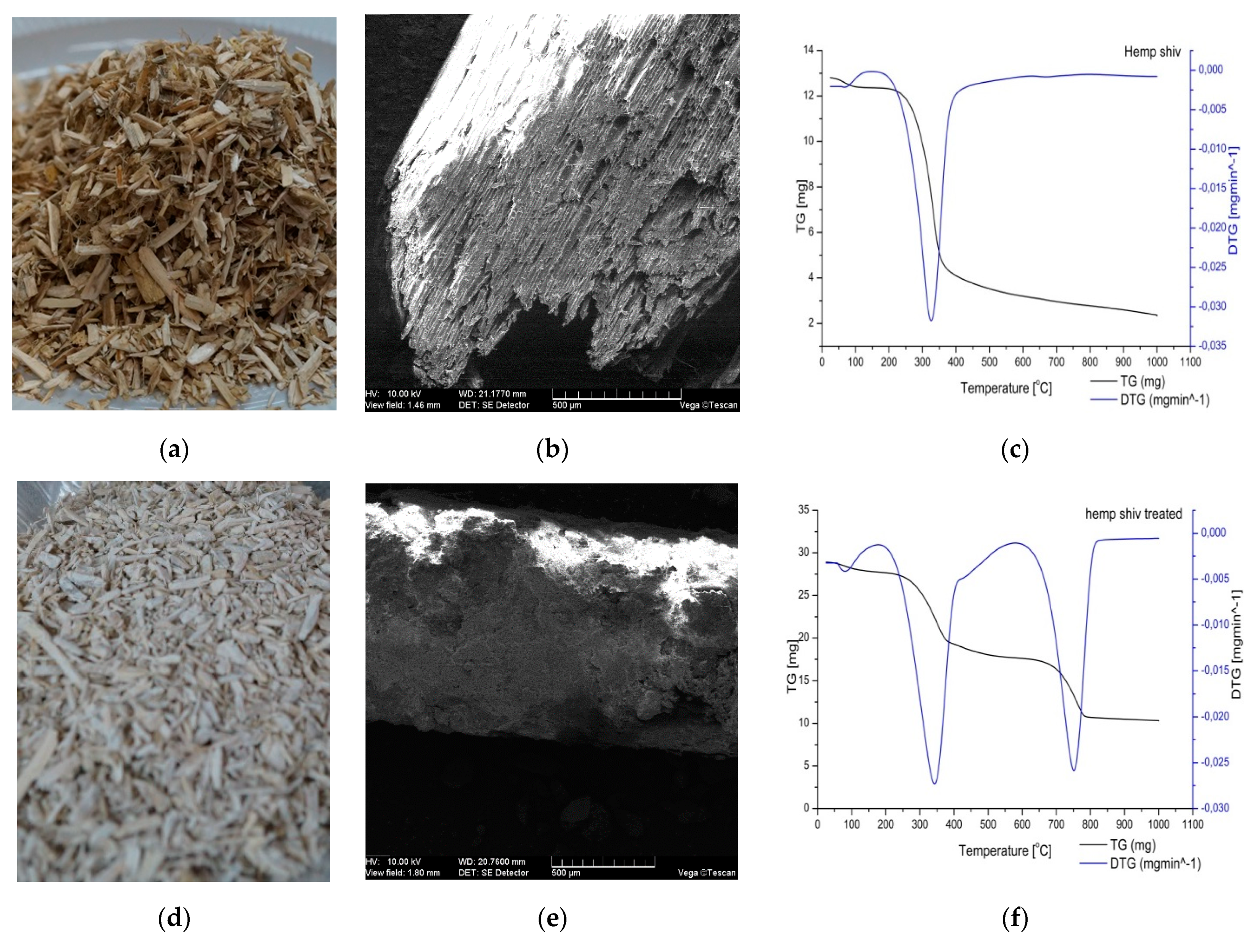
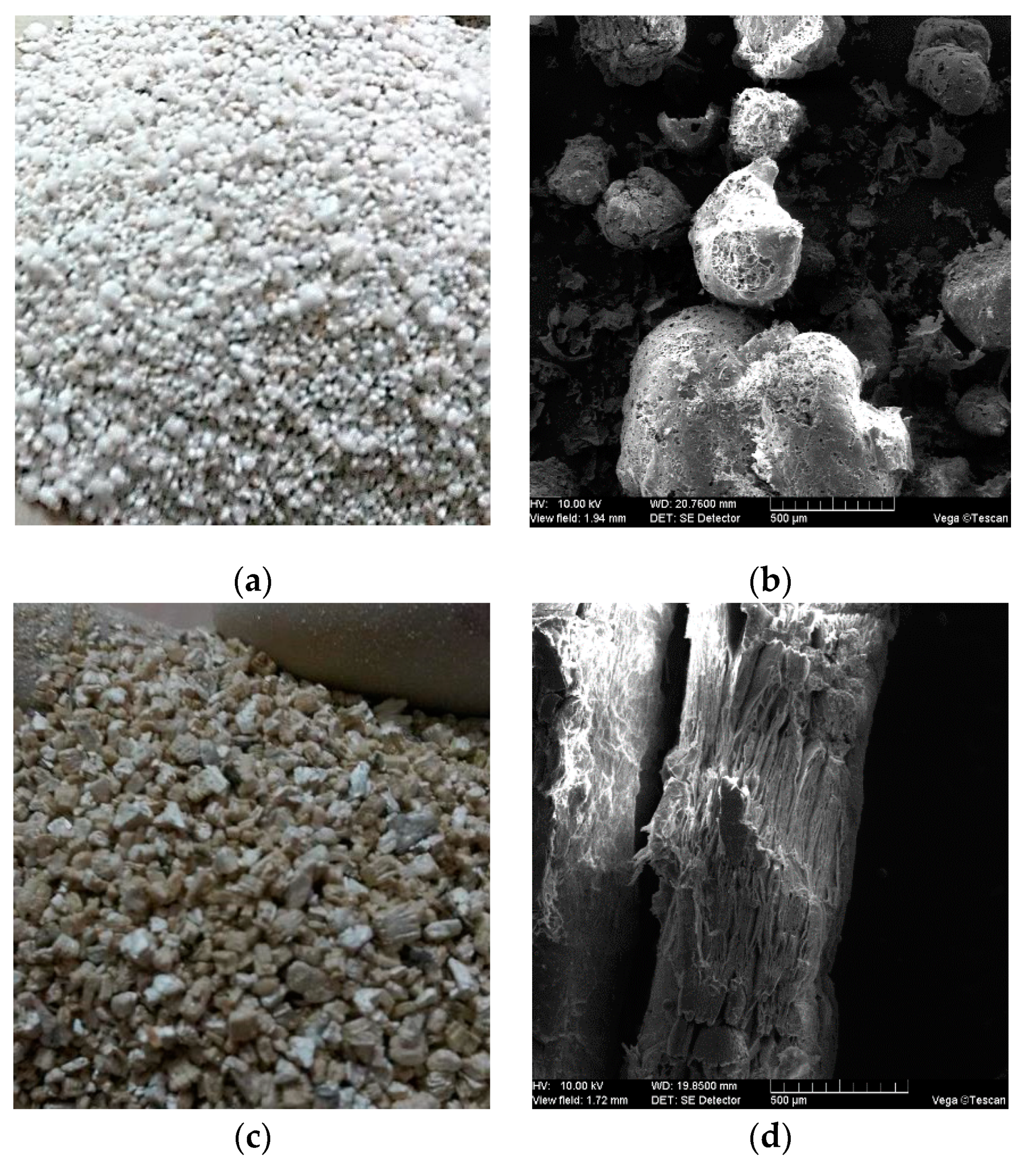
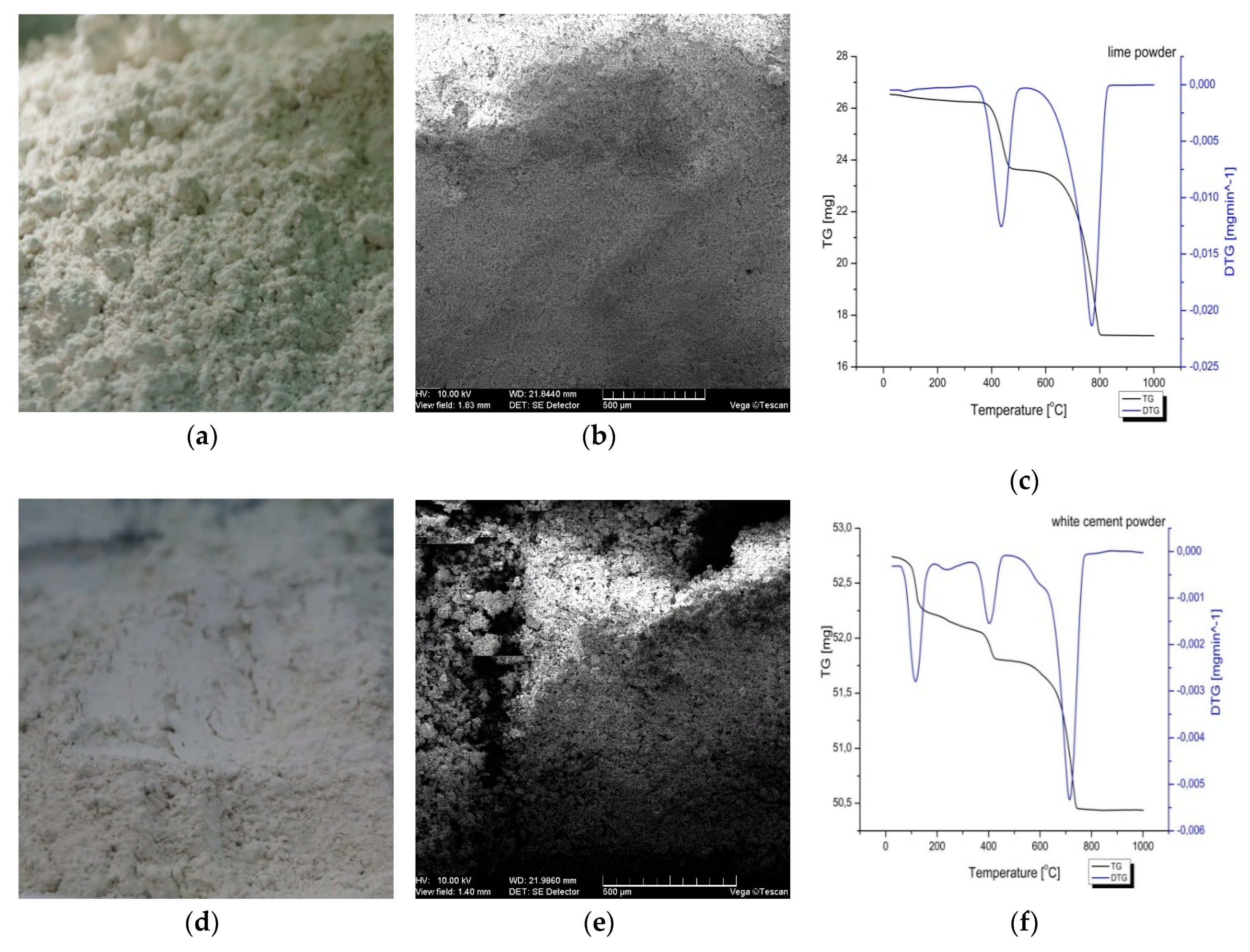

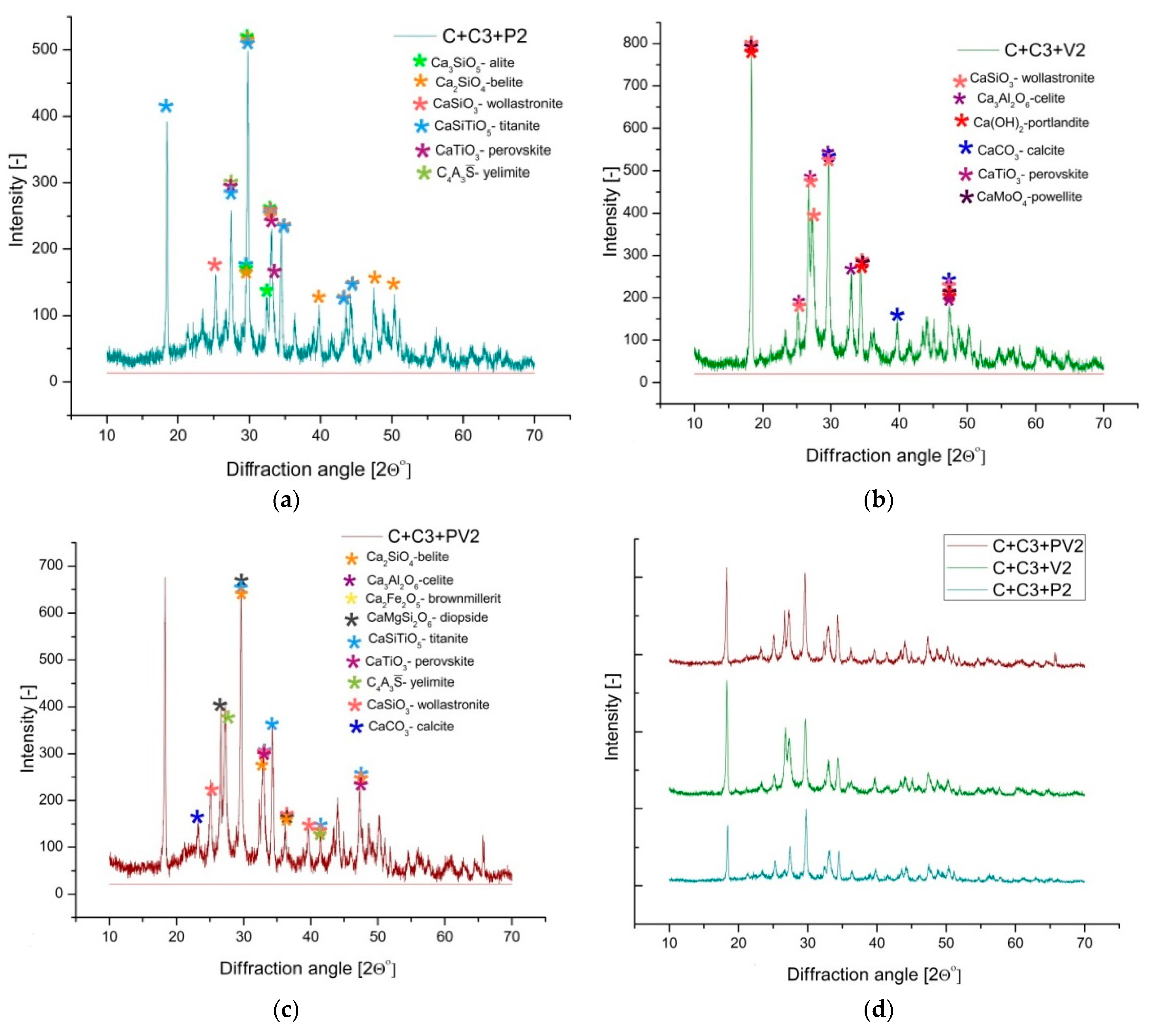
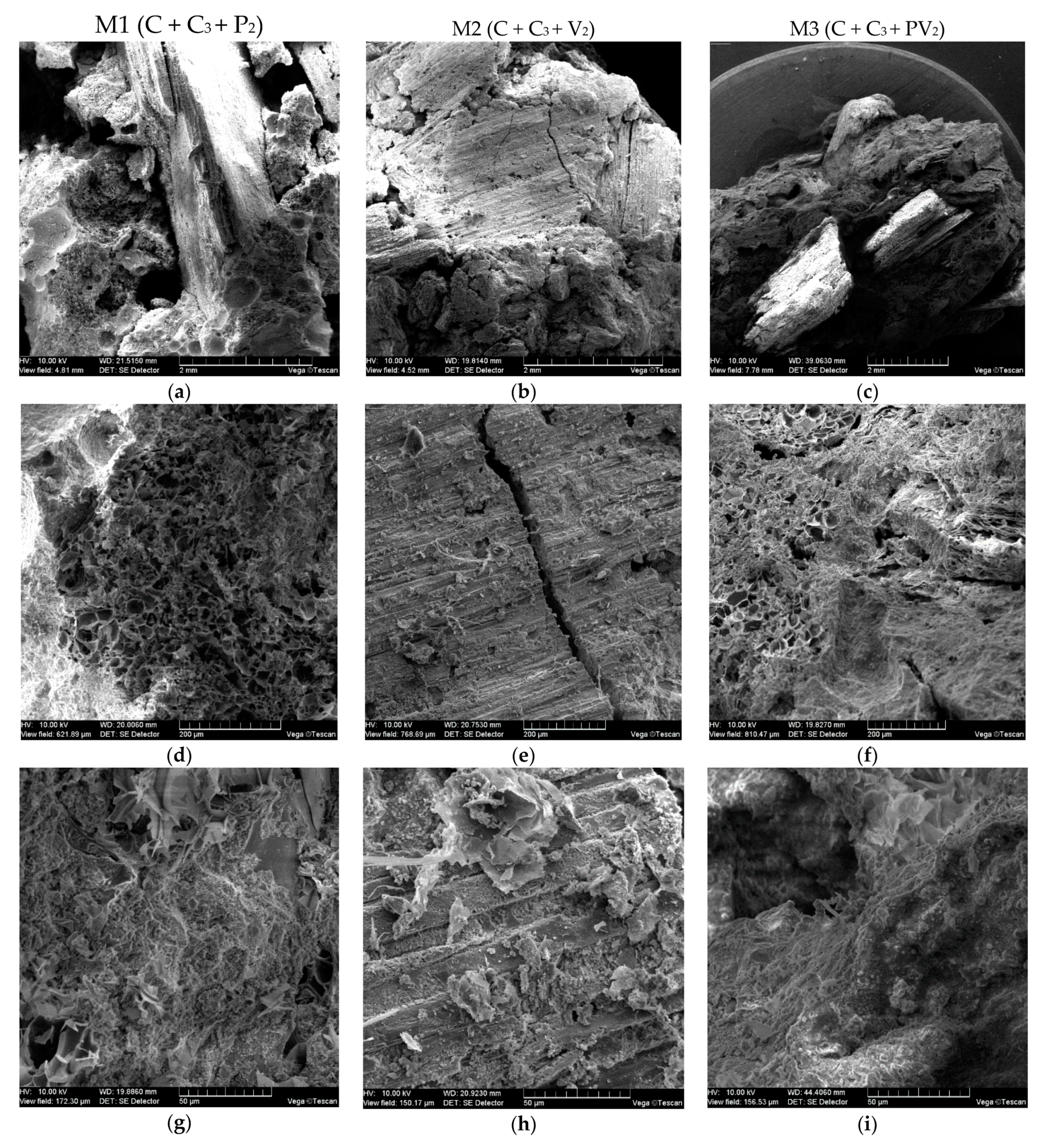
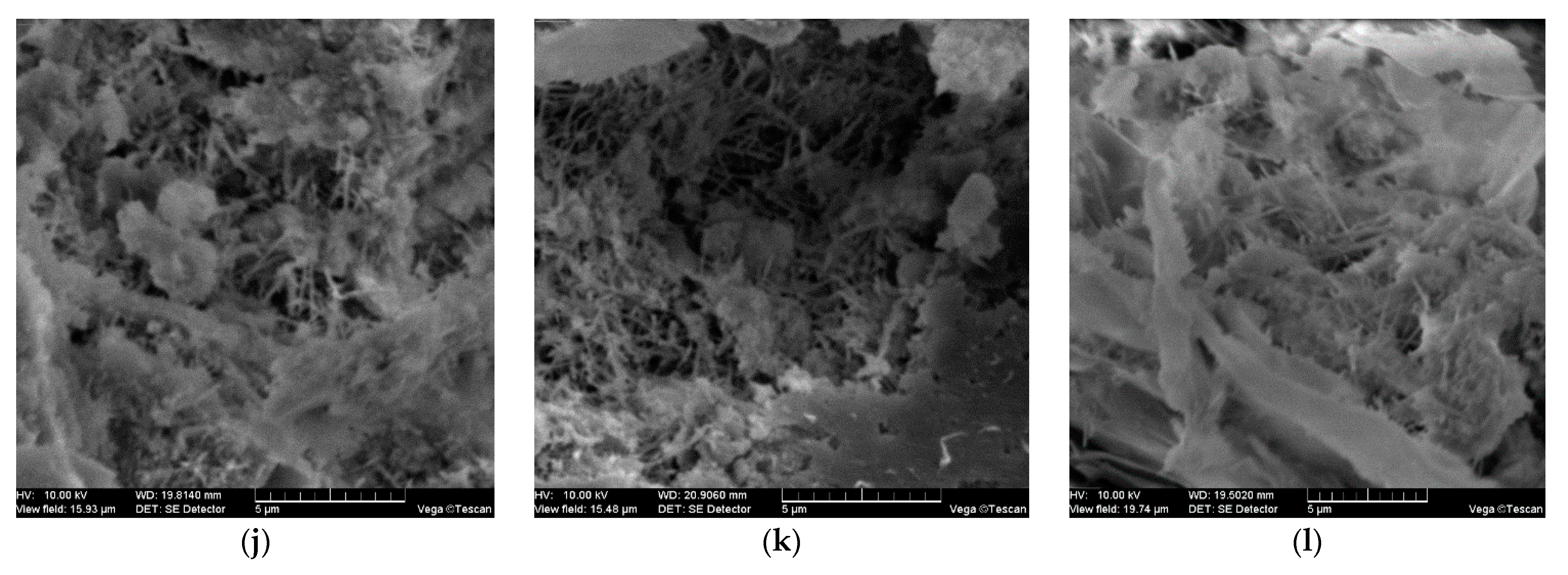
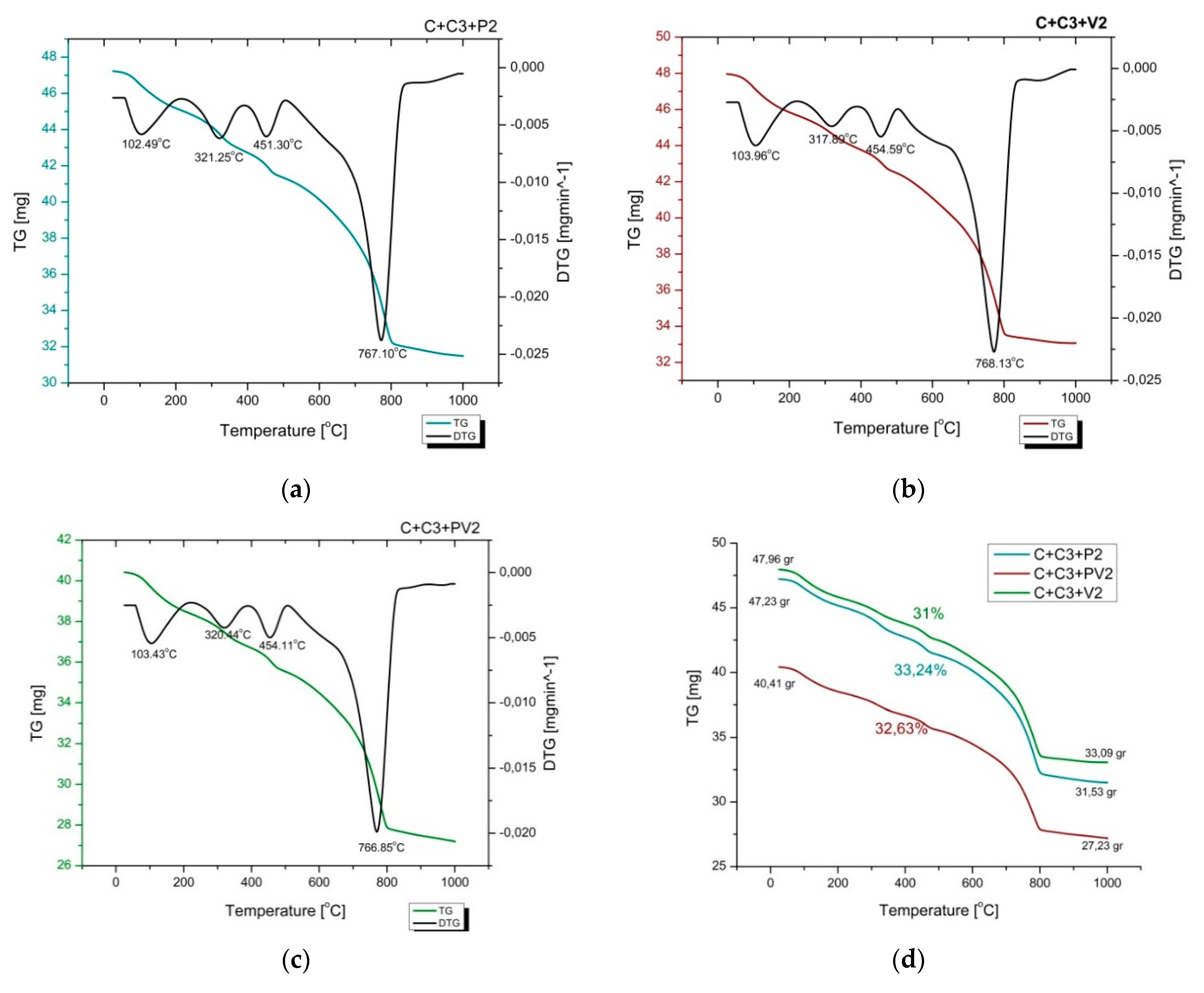
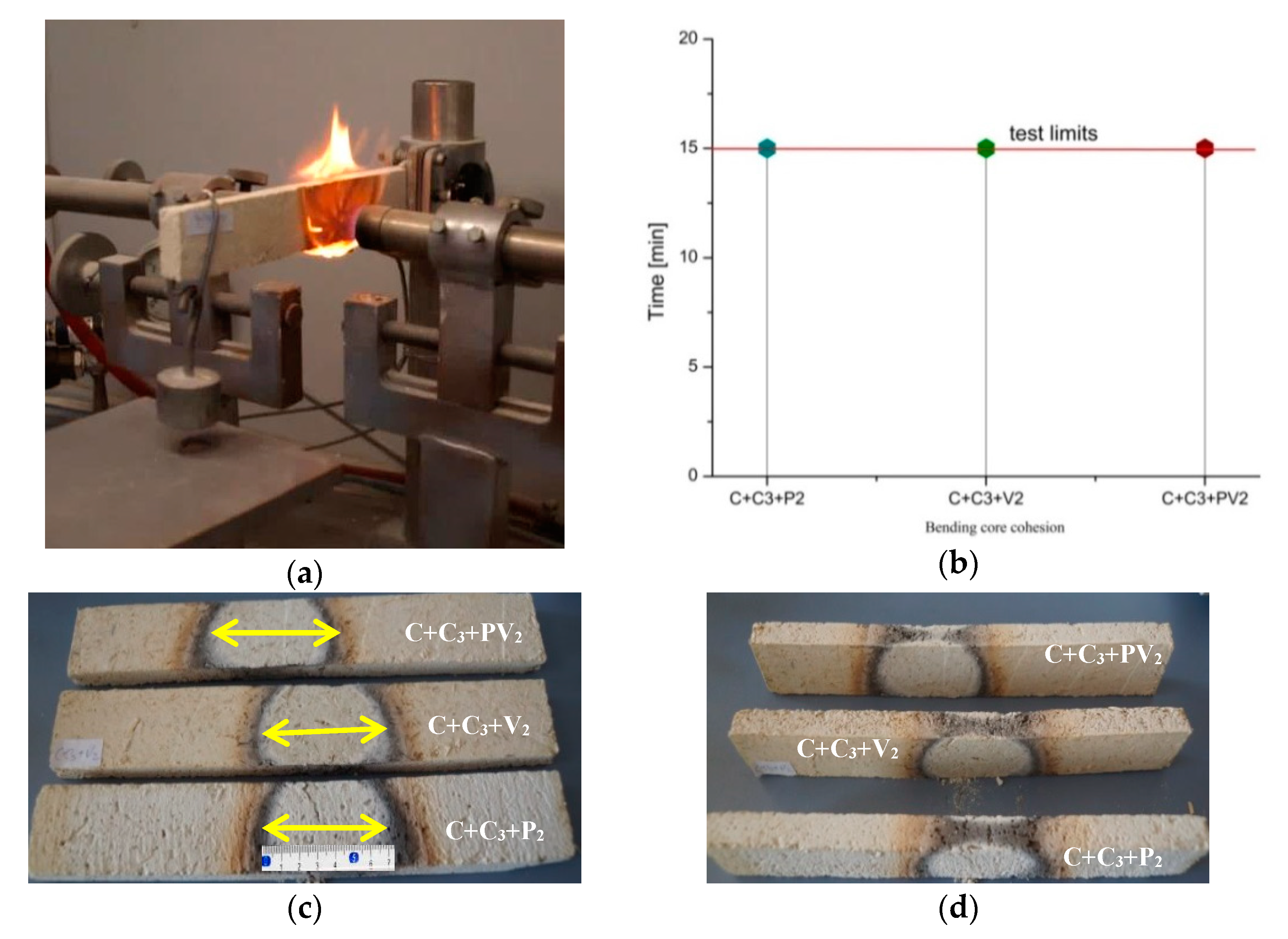
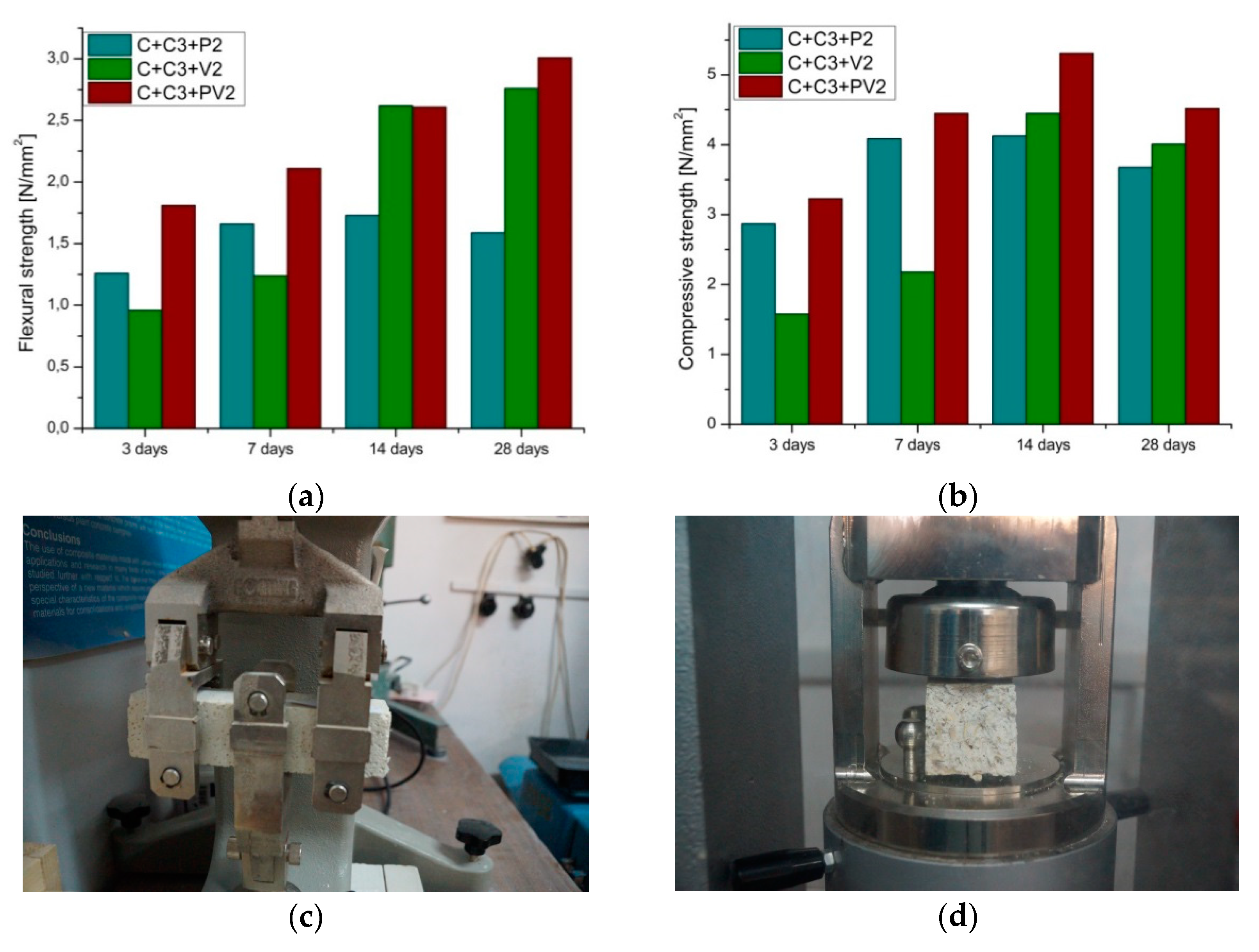
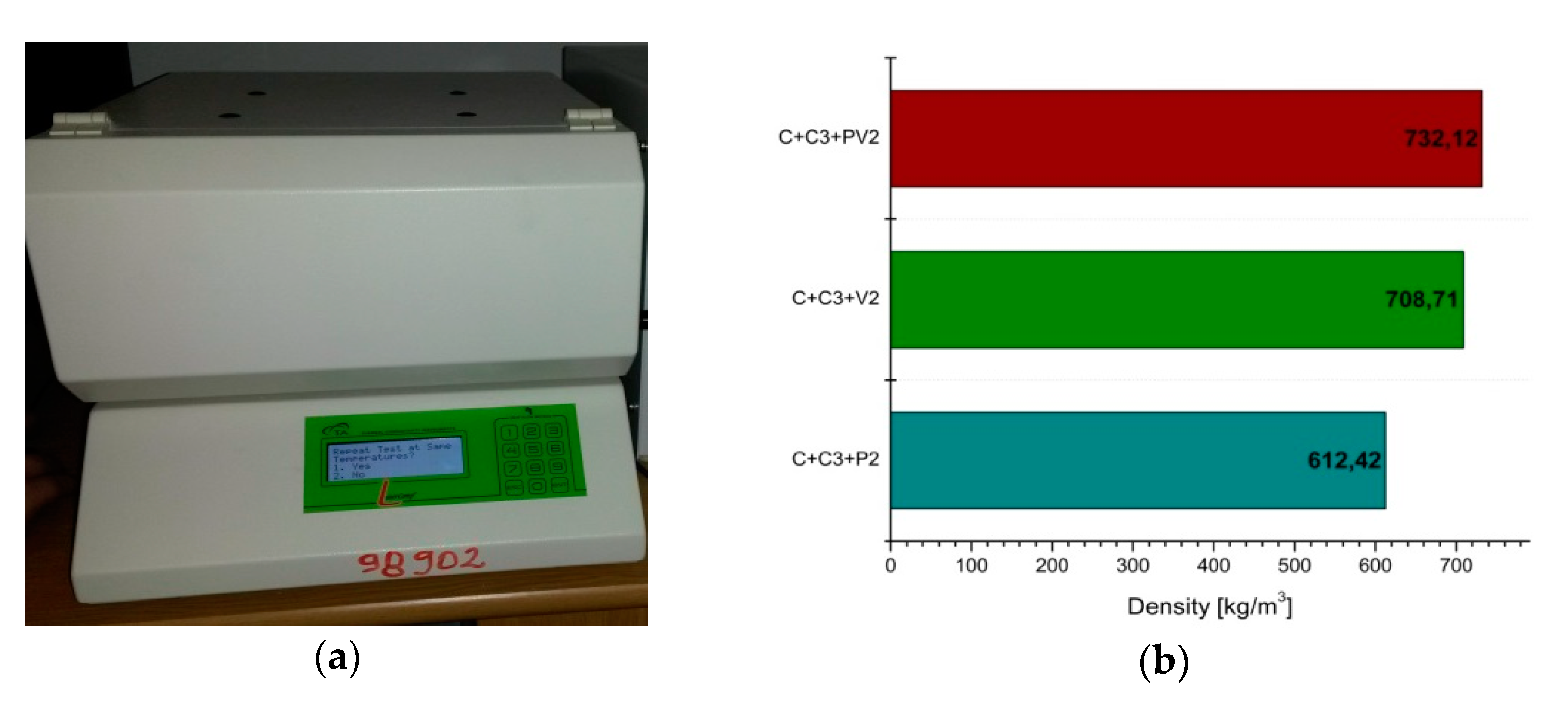
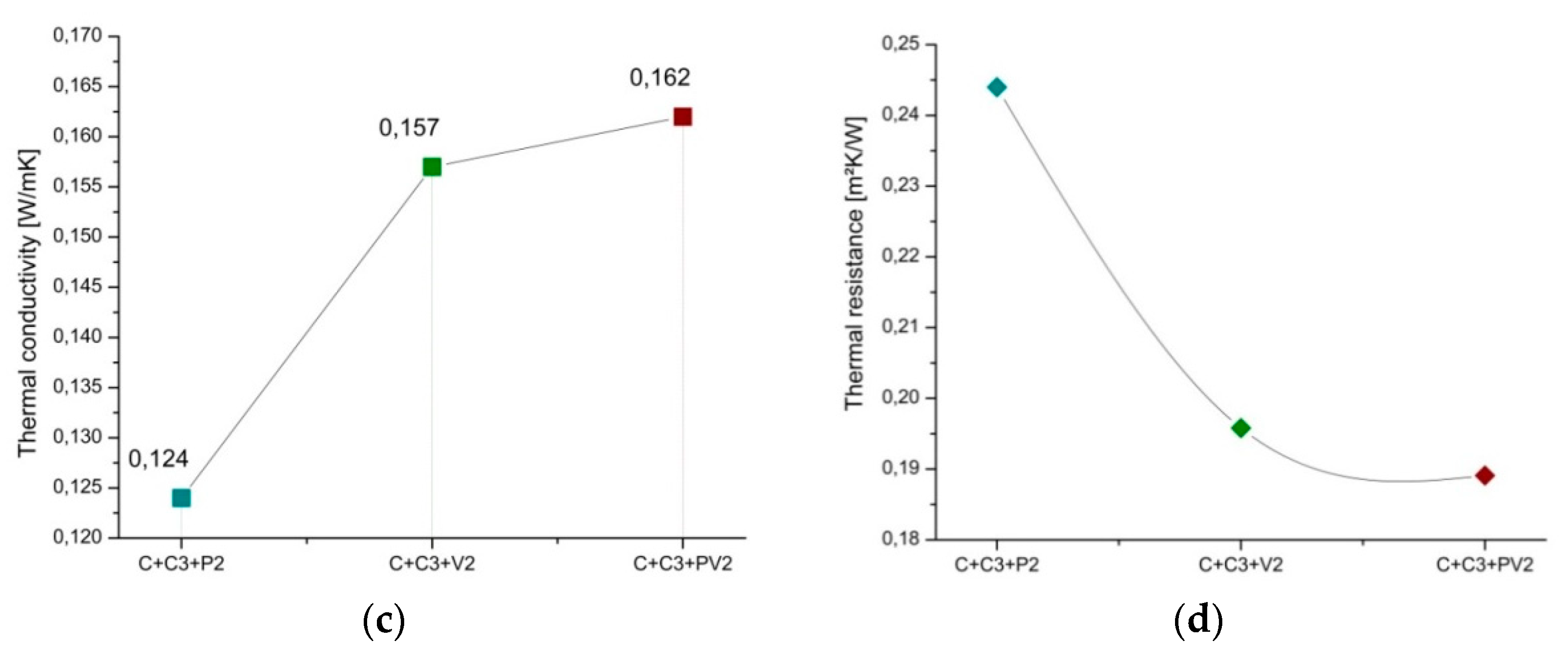
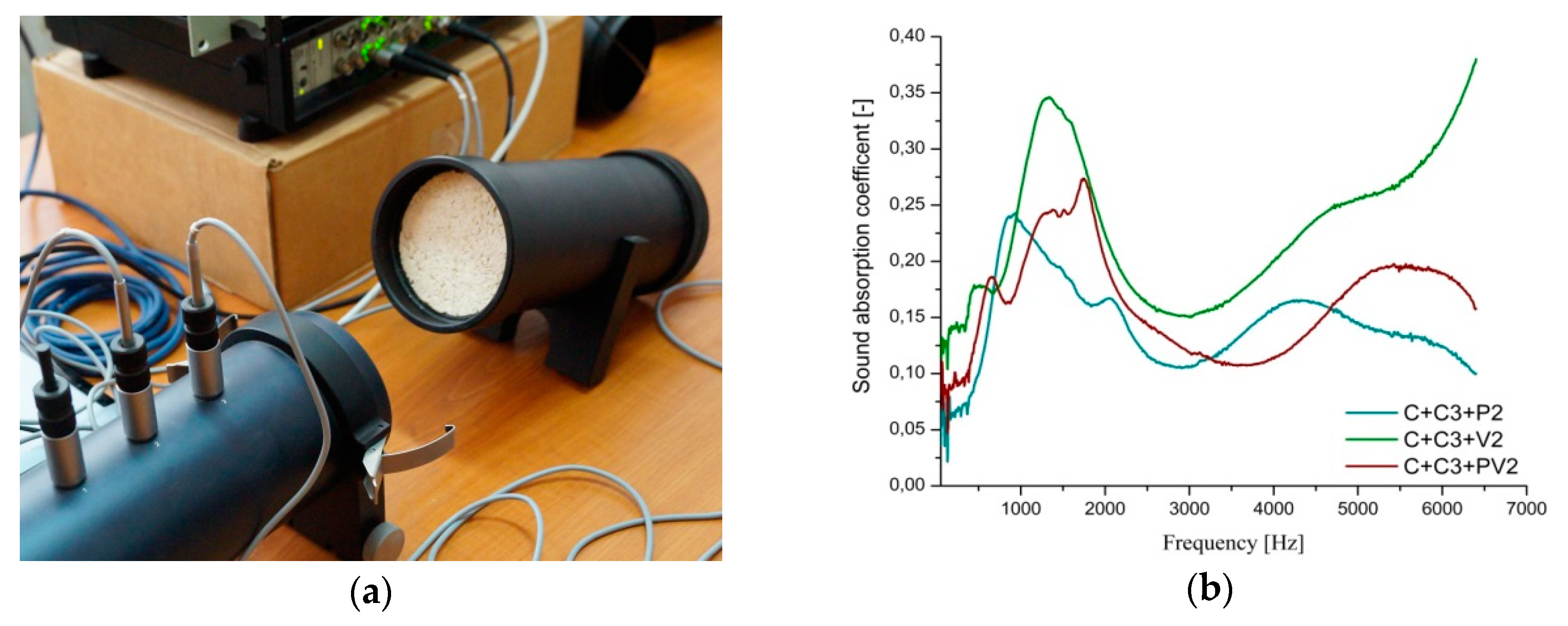
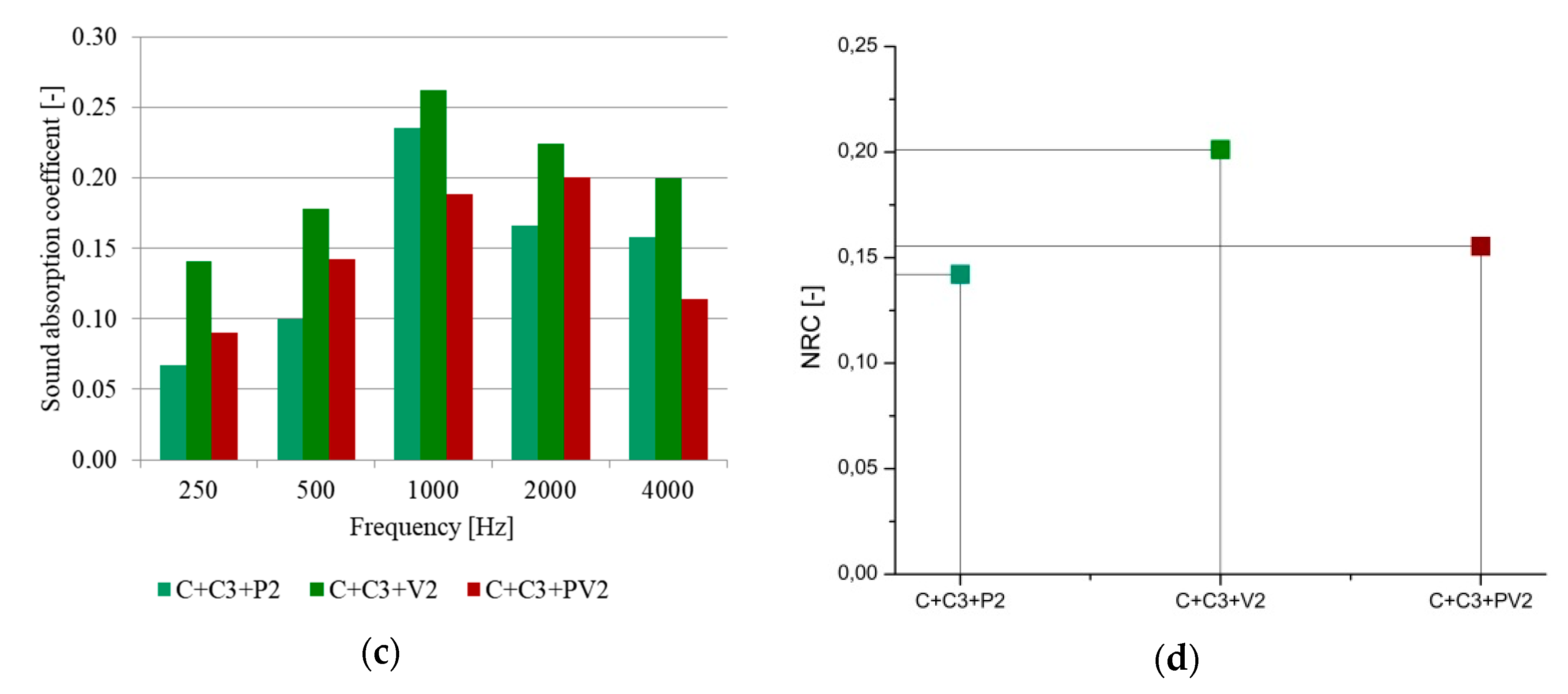
| Identification Name in the Text Composition Name | M1 C + C3 + P2 | M2 C + C3 + V2 | M3 C + C3 + PV2 |
|---|---|---|---|
| Ratio by Volumes | |||
| White cement (C) | 1 | 1 | 1 |
| Hemp shiv (C) | 3 | 3 | 3 |
| Perlite (P) | 2 | - | 1 |
| Vermiculite(V) | - | 2 | 1 |
| Water | 1 | 1 | 1 |
| Composition | M1 (C + C3 + P2) | M2 (C + C3 + V2) | M3 (C + C3 + PV2) | |||
|---|---|---|---|---|---|---|
| UM | % | mg | % | mg | % | mg |
| 100 | 47.23 | 100 | 47.93 | 100 | 40.41 | |
| 0–220 °C | 4.63 | 2.19 | 4.71 | 2.26 | 4.98 | 2.01 |
| 220–400 °C | 4.86 | 2.29 | 4.01 | 1.92 | 4.19 | 1.69 |
| 400–500 °C | 2.94 | 1.39 | 2.69 | 1.29 | 2.86 | 1.15 |
| 500–1000 °C | 20.80 | 9.82 | 19.06 | 9.40 | 20.57 | 8.31 |
| total | 33.24 | 15.70 | 31.00 | 14.87 | 32.63 | 13.18 |
© 2020 by the authors. Licensee MDPI, Basel, Switzerland. This article is an open access article distributed under the terms and conditions of the Creative Commons Attribution (CC BY) license (http://creativecommons.org/licenses/by/4.0/).
Share and Cite
Iștoan, R.; Tămaș-Gavrea, D.R.; Manea, D.L. Experimental Investigations on the Performances of Composite Building Materials Based on Industrial Crops and Volcanic Rocks. Crystals 2020, 10, 102. https://doi.org/10.3390/cryst10020102
Iștoan R, Tămaș-Gavrea DR, Manea DL. Experimental Investigations on the Performances of Composite Building Materials Based on Industrial Crops and Volcanic Rocks. Crystals. 2020; 10(2):102. https://doi.org/10.3390/cryst10020102
Chicago/Turabian StyleIștoan, Raluca, Daniela Roxana Tămaș-Gavrea, and Daniela Lucia Manea. 2020. "Experimental Investigations on the Performances of Composite Building Materials Based on Industrial Crops and Volcanic Rocks" Crystals 10, no. 2: 102. https://doi.org/10.3390/cryst10020102
APA StyleIștoan, R., Tămaș-Gavrea, D. R., & Manea, D. L. (2020). Experimental Investigations on the Performances of Composite Building Materials Based on Industrial Crops and Volcanic Rocks. Crystals, 10(2), 102. https://doi.org/10.3390/cryst10020102






